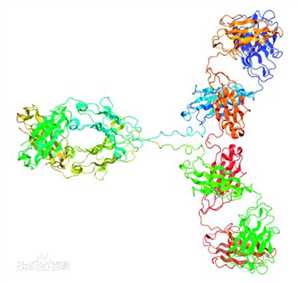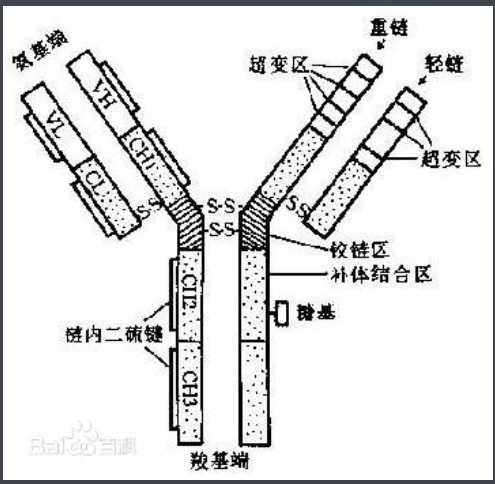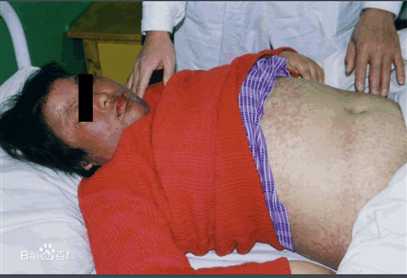标签:
IgG是免疫球蛋白G(Immunoglobulin G,IgG)的缩写,是血清主要的抗体成分,约占血清Ig的75%。其中40~50%分布于血清中,其余分布在组织中。IgG是唯一可以通过胎盘的免疫球 蛋白。IgG的功能作用主要在机体免疫中起保护作用,大多数抗菌、抗病毒;应对麻疹、甲型肝炎等,能有效地预防相应的感染性疾病。其指标对于诊断某些疾病 具有意义。

IgG是免疫球蛋白G(Immunoglobulin G,IgG)的缩写。根据结构的不同将免疫球蛋白分为五种,IgG是人的免疫球蛋白之一,其他还有lgA、lgM、IgD和lgE.。



IgG主要由脾、淋巴结中的浆细胞合成和分泌,以单体形式存在。在个体发育过程中机体合成IgG的年龄要晚于IgM,在出生后的第三个月开始合成,3~5岁接近成年人的水平。40岁后逐渐下降。
IgG是唯一可以通过胎盘的免疫球蛋白。来自母体的IgG在出生后数月对防御白喉、麻疹、脊髓灰质炎等感染起着重要作用,母体传递给胎儿的IgG于生后6个月几乎全部消失,而婴儿自身产生IgG从3个月时才逐渐增多,故6个月后易患感染。3-5岁是渐接近成人水平
胎儿出生前可从母体获得IgG,在孕前期22~28周间,胎儿血IgG浓度与母体血IgG浓度相等,出生后母体IgG逐渐减少,到第3、4月胎儿血IgG降至最低,随后胎儿逐渐开始合成IgG,血清IgG逐渐增加,到16岁前达到成人水平。
Antibodies are major components of humoral immunity. IgG is the main type of antibody found in blood and extracellular fluid allowing it to control infection of body tissues. By binding many kinds of pathogens such as viruses, bacteria, and fungi, IgG protects the body from infection. It does this through several mechanisms: IgG-mediated binding of pathogens causes their immobilization and binding together via agglutination; IgG coating of pathogen surfaces (known as opsonization) allows their recognition and ingestion by phagocytic immune cells; IgG activates the classical pathway of the complement system, a cascade of immune protein production that results in pathogen elimination; IgG also binds and neutralizes toxins. IgG also plays an important role in antibody-dependent cell-mediated cytotoxicity (ADCC) and intracellular antibody-mediated proteolysis, in which it binds to TRIM21 (the receptor with greatest affinity to IgG in humans) in order to direct marked virions to the proteasome in the cytosol.[2] IgG is also associated with type II and type III hypersensitivity reactions.
IgG antibodies are generated following class switching and maturation of the antibody response and thus participate predominantly in the secondary immune response.[3] IgG is secreted as a monomer that is small in size allowing it to easily perfuse tissues. It is the only isotype that has receptors to facilitate passage through the human placenta, thereby providing protection to the fetus in utero. Along with IgA secreted in the breast milk, residual IgG absorbed through the placenta provides the neonate with humoral immunity before its own immune system develops. Colostrum contains a high percentage of IgG, especially bovine colostrum. In individuals with prior immunity to a pathogen, IgG appears about 24–48 hours after antigenic stimulation.
IgG antibodies are large molecules of about 150[4][5] kDa made of four peptide chains. It contains two identical class γ heavy chains of about 50 kDa and two identical light chains of about 25 kDa, thus a tetrameric quaternary structure. The two heavy chains are linked to each other and to a light chain each by disulfide bonds. The resulting tetramer has two identical halves, which together form the Y-like shape. Each end of the fork contains an identical antigen binding site. The various regions and domains of a typical IgG are depicted in the figure to the left. The Fc regions of IgGs bear a highly conserved N-glycosylation site. The N-glycans attached to this site are predominantly core-fucosylated diantennary structures of the complex type. In addition, small amounts of these N-glycans also bear bisecting GlcNAc and α-2,6-linked sialic acid residues.[6]
There are four IgG subclasses (IgG1, 2, 3, and 4) in humans, named in order of their abundance in serum (IgG1 being the most abundant).
| Name | Percent | Crosses placenta easily | Complement activator | Binds to Fc receptor on phagocytic cells | Half Life[7] |
| IgG1 | 66% | yes (1.47)* | second-highest | high affinity | 21 days |
| IgG2 | 23% | no (0.8)* | third-highest | extremely low affinity | 21 days |
| IgG3 | 7% | yes (1.17)* | highest | high affinity | 7 days |
| IgG4 | 4% | yes (1.15)* | no | intermediate affinity | 21 days |
| * Quota cord/maternity concentrations blood. Based on data from a Japanese study on 228 mothers.[8] | |||||
Note: IgG affinity to Fc receptors on phagocytic cells is specific to individual species from which the antibody comes as well as the class. The structure of the hinge regions (region 6 in the diagram) contributes to the unique biological properties of each of the four IgG classes. Even though there is about 95% similarity between their Fc regions, the structure of the hinge regions is relatively different.
Given the opposing properties of the IgG subclasses (fixing and failing to fix complement; binding and failing to bind FcR), and the fact that the immune response to most antigens includes a mix of all four subclasses, it has been difficult to understand how IgG subclasses can work together to provide protective immunity. Recently the Temporal Model of human IgE and IgG function was proposed.[9] This model suggests that IgG3 (and IgE) appear early in a response. The IgG3, though of relatively low affinity, allows IgG-mediated defences to join IgM-mediated defences in clearing foreign antigens. Subsequently, higher affinity IgG1 and IgG2 are produced. The relative balance of these subclasses, in any immune complexes that form, helps determine the strength of the inflammatory processes that follow. Finally, if antigen persists, high affinity IgG4 is produced, which dampens down inflammation by helping to curtail FcR-mediated processes.
The relative ability of different IgG subclasses to fix complement may explain why some anti-donor antibody responses do harm a graft after organ transplantation.[10]
In a mouse model of autoantibody mediated anemia using IgG isotype switch variants of an anti erythrocytes autoantibody, it was found that mouse IgG2a was superior to IgG1 in activating complement. Moreover, it was found that the IgG2a isotype was able to interact very efficiently with FcgammaR. As a result, 20 times higher doses of IgG1, in relationship to IgG2a autoantibodies, were required to induce autoantibody mediated pathology.[11] It is important to remember that mouse IgG1 and human IgG1 are not necessarily similar in function, and the inference of human antibody function from mouse studies must be done with great care. Nevertheless it remains true that both human and mouse antibodies have different abilities to fix complement and to bind to Fc receptors.
The measurement of immunoglobulin G can be a diagnostic tool for certain conditions, such as autoimmune hepatitis, if indicated by certain symptoms.[12] Clinically, measured IgG antibody levels are generally considered to be indicative of an individual‘s immune status to particular pathogens. A common example of this practice are titers drawn to demonstrate serologic immunity to measles, mumps, and rubella (MMR), hepatitis B virus, and varicella (chickenpox), among others.[13]
Testing of IgG is not indicated for diagnosis of allergy.[14][15]
IgG antibodies are extracted from donated blood plasma and used as a therapeutic known as intravenous immunoglobulin (IVIG). This is used to treat immune deficiencies, autoimmune disorders, and infections.
标签:
原文地址:http://www.cnblogs.com/biopy/p/4599145.html